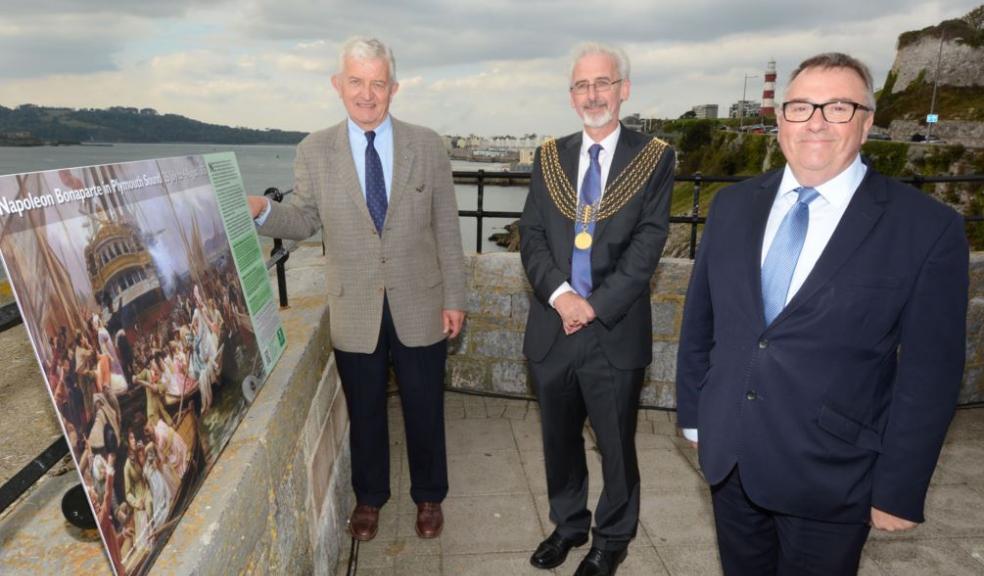
Plaque marks Napoleon's link with Plymouth
A plaque to mark the amazing 10 days Napoleon Bonaparte spent captive in Plymouth Sound was unveiled today – exactly 200 years since his arrival in St Helena on 16 October 1815.
The monument – a piece of stone from St Helena embedded in granite from Dartmoor prison – where thousands French prisoners were held during the Napoleonic wars – was unveiled by Alain Sibiril, Honorary Consul of France in Plymouth and the Lord Mayor of Plymouth together with Mrs Kedell Worboys, St Helena Government UK Representative.
Napoleon was held in Plymouth onboard HMS Bellerophon from 26 July to 4 August 1815 following his defeat at Waterloo while the British Government decided his fate.
Thousands of people from Plymouth and much further afield, came to try to catch sight of the ‘Fallen Emperor’; a man the British had been fighting for some 22 years.
He was send into exile on the South Atlantic Island of St Helena. Napoleon and the Bellerophon left Plymouth Sound and he was transferred to HMS Northumberland for the long voyage south. He died on 5 May 1821, in exile, on St Helena.
At a moving ceremony overlooking the Sound where thousands rowed out in boats to see Napoleon, Monsieur Sibiril told the crowd the day was also about the enduring peace between the two nations. He said: “2015 is an appropriate time to commemorate the enduring peace which has prevailed between our two countries as friends and allies. These stones and plaques will not only be another historic landmark for our maritime city but are intended to help ensure our close relationship endures.”
The plaques on Madeira Road have been funded by Alain Sibiril with the help of Plymouth City Council, the Franco-British community, St Helena Tourism and Brittany Ferries.
Representatives from HMS Northumberland, together with officers from the French Navy, were also guests at the ceremony – along with another rather large guest – the Brittany Ferries vessel, Pont Aven – appeared in the Sound and blew its horn in appreciation.
The volcanic stone embedded in the Dartmoor Granite comes from Longwood House, Napoleon’s home on St Helena, which was transported to Plymouth by the French Navy and Brittany Ferries.
It beards the inscription ‘May our hearts be open to friendship and our arms reach across the sea to unite our two nations is inscribed on the plaque,’ written by Mrs Melisande Fitzsimons, a French poet living in Plymouth.
Deputy Leader Councillor Peter Smith said: “This has been a fantastic event and has helped bring a fascinating piece of Plymouth’s amazing history to a wider audience.
“People will be able to walk past this place and imagine the scene where thousands of people flocked to see Napoleon. The Napoleonic Wars shaped this city and we are delighted to have our French friends here to mark 200 years of friendship."
Mrs Kedell Worboys, St Helena Government UK Representative told the crowd: “A little piece of St Helena will now always be in Plymouth.”
The City Council erected a graphic panel featuring the popular painting by the artist Jules Girardet from the City’s Art Collection. Although painted long after the event, in the 1890s, the Girardet captures the flavour of those ten amazing days.
The Lord Mayor was joined by Anna Roden, an A Level student from Devonport High School for Girls and Paul Rouve, the son of a French naval officer living in Plymouth. Anna read a poem she had written about the Bellerophon and Napoleon in Plymouth Sound.
Others who attended included Council leader Tudor Evans, Deputy Leader Peter Smith, Amanda Lumley, Destination Plymouth, Oliver Colvile Plymouth MP, Mrs Bridie Oakes-Richard HMP Dartmoor Governor, Gordon Oliver, Elected Mayor of Torquay, Commodore J. Miller CBE Royal Navy, Naval Regional Commander (Wales & Western England) Cdr Patricia Kohn, Co HMS Northumberland, Cdr E. Rouve - French Navy, John Napton MD of Brittany Ferries and Richard Price, Marketing Manager Brittany Ferries














